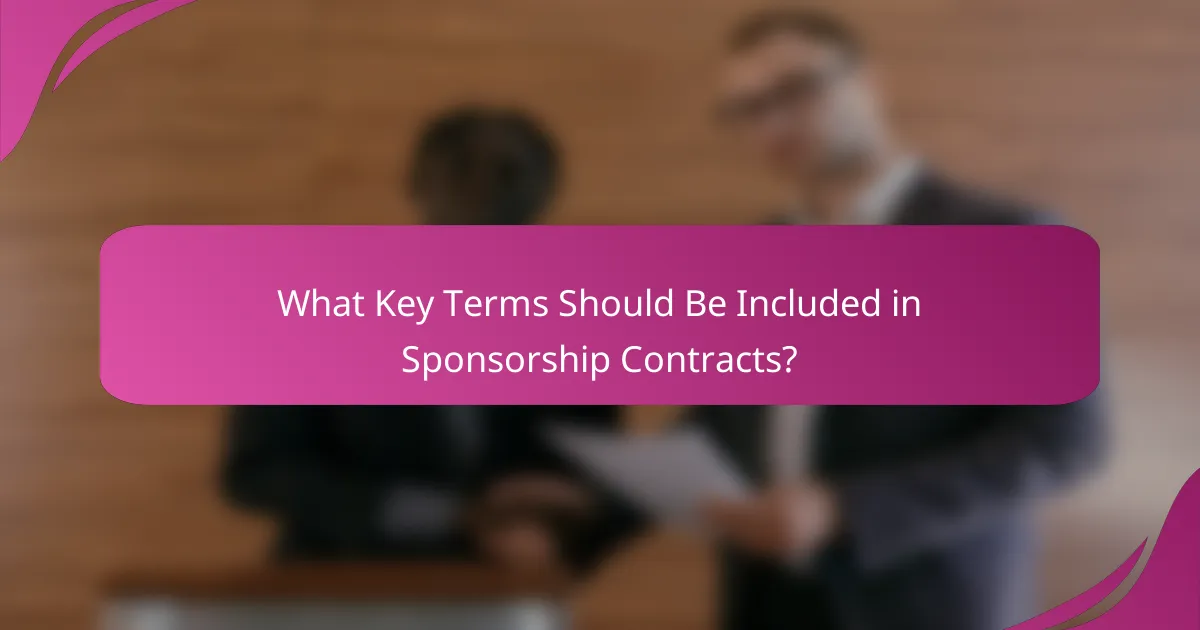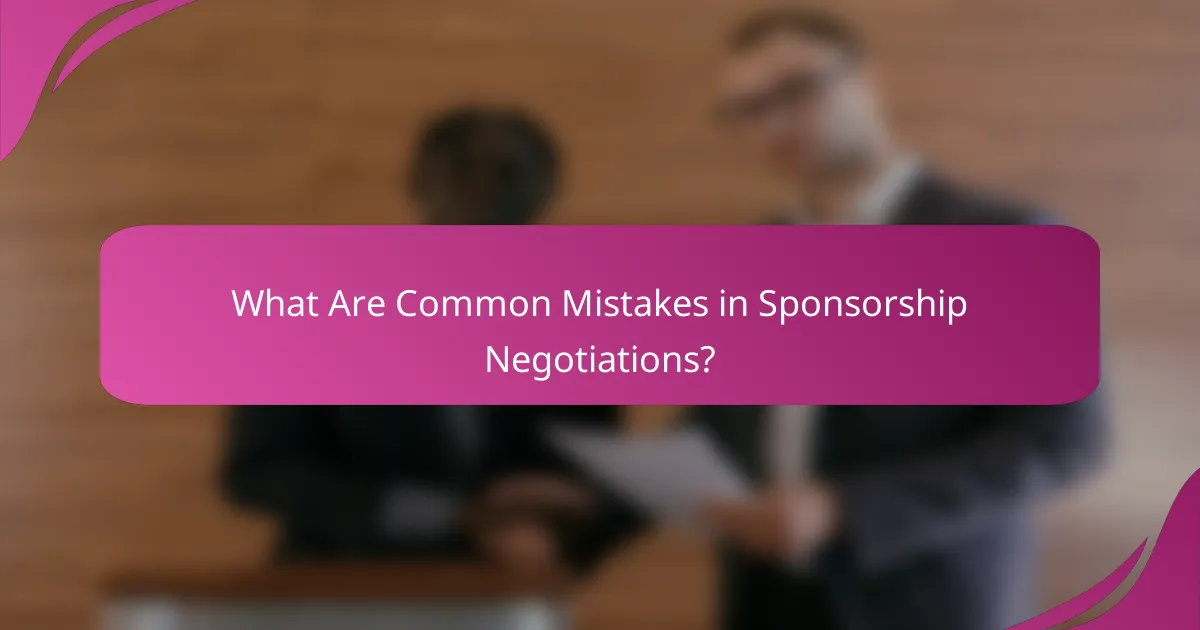Negotiating sponsorship contracts requires a strategic approach that emphasizes preparation and mutual benefits. By understanding key terms and fostering strong relationships, parties can create agreements that meet their respective goals. Additionally, evaluating the outcomes of these contracts is crucial for assessing their effectiveness and potential for future collaborations.

What Are Effective Strategies for Negotiating Sponsorship Contracts?
Effective strategies for negotiating sponsorship contracts involve thorough preparation, understanding mutual benefits, and fostering strong relationships. By employing targeted tactics and setting clear goals, you can create agreements that satisfy both parties.
Researching potential sponsors
Before entering negotiations, conduct comprehensive research on potential sponsors to understand their brand values, target audience, and previous sponsorships. This knowledge helps tailor your proposal to align with their objectives and enhances the likelihood of a successful partnership.
Utilize online resources, industry reports, and social media to gather insights about sponsors. Create a list of potential sponsors that fit your brand and mission, prioritizing those with a history of supporting similar initiatives.
Understanding value propositions
Clearly define your value proposition to demonstrate what you can offer to sponsors. This includes audience reach, engagement metrics, and unique promotional opportunities that can enhance their brand visibility.
Consider creating a benefits checklist that outlines potential returns for sponsors, such as brand exposure, access to new markets, or enhanced corporate social responsibility. Tailor this checklist to reflect the specific interests of each sponsor you approach.
Building relationships with sponsors
Establishing and nurturing relationships with potential sponsors is crucial for successful negotiations. Attend industry events, engage on social media, and participate in networking opportunities to connect with key decision-makers.
Focus on building trust and rapport by showing genuine interest in their goals and challenges. A strong relationship can lead to more favorable terms and long-term partnerships.
Utilizing negotiation tactics
Employ effective negotiation tactics to achieve optimal outcomes. Start by clearly articulating your needs and be prepared to listen to the sponsor’s requirements. This two-way communication fosters collaboration and can lead to mutually beneficial agreements.
Consider using techniques such as anchoring—starting with a higher initial offer to leave room for concessions. Be flexible and open to creative solutions that can satisfy both parties’ interests.
Setting clear objectives
Establish clear objectives before entering negotiations to guide your discussions and maintain focus. Define what success looks like for you, including financial terms, deliverables, and timelines.
Document these objectives and prioritize them to ensure you address the most critical aspects during negotiations. Regularly revisit these goals to stay aligned with your vision throughout the process.

What Key Terms Should Be Included in Sponsorship Contracts?
Key terms in sponsorship contracts establish the framework for the partnership, outlining expectations and responsibilities. Essential elements include duration, financial commitments, rights and obligations, termination clauses, and exclusivity agreements.
Duration of sponsorship
The duration of sponsorship specifies how long the agreement will last, which can range from a few months to several years. It’s crucial to define start and end dates clearly to avoid misunderstandings. Consider including options for renewal or extension to facilitate ongoing partnerships.
When negotiating duration, evaluate the alignment with your marketing goals and the sponsor’s objectives. Shorter terms may allow for flexibility, while longer agreements can provide stability and deeper brand integration.
Financial commitments
Financial commitments detail the monetary contributions from the sponsor, which can include cash payments, in-kind services, or product donations. Clearly outline the total amount, payment schedule, and any additional financial obligations, such as performance bonuses or penalties for non-compliance.
Be mindful of market standards when negotiating financial terms. Research similar sponsorship deals to ensure your expectations are realistic and competitive, which can help in securing a favorable agreement.
Rights and obligations
Rights and obligations define what each party is entitled to and responsible for during the sponsorship. This includes promotional rights, branding visibility, and any specific deliverables required from both sides. Clearly articulating these terms helps prevent conflicts and ensures accountability.
Consider including metrics for measuring success, such as audience reach or engagement levels, to assess the effectiveness of the sponsorship. This can foster a collaborative approach to achieving mutual goals.
Termination clauses
Termination clauses outline the conditions under which either party can end the sponsorship agreement prematurely. Common reasons for termination include breach of contract, failure to meet obligations, or changes in business circumstances. It’s essential to specify the notice period required for termination.
Including a clear termination process can protect both parties and provide a structured exit strategy. Consider adding provisions for resolving disputes to minimize potential legal complications.
Exclusivity agreements
Exclusivity agreements prevent the sponsor from partnering with competing brands during the sponsorship period. This can enhance the value of the sponsorship by ensuring that the sponsor’s brand is the sole representative in its category. Clearly define the scope of exclusivity, including any geographic or product limitations.
When negotiating exclusivity, weigh the benefits against potential limitations on future partnerships. Ensure that the terms are reasonable and do not overly restrict your ability to engage with other sponsors in the market.

How to Measure the Outcomes of Sponsorship Contracts?
Measuring the outcomes of sponsorship contracts involves evaluating various metrics that reflect the effectiveness and impact of the sponsorship. Key areas to focus on include financial returns, brand visibility, audience interaction, and the potential for ongoing partnerships.
Return on investment (ROI)
Return on investment (ROI) is a crucial metric for assessing the financial effectiveness of sponsorship contracts. To calculate ROI, compare the revenue generated from the sponsorship against the costs incurred. A positive ROI indicates that the sponsorship is financially beneficial, while a negative ROI suggests a need for reevaluation.
Common benchmarks for ROI in sponsorships can vary widely, but many organizations aim for at least a 2:1 ratio, meaning for every dollar spent, two dollars should be generated in return. Regularly tracking these figures helps in making informed decisions about future sponsorships.
Brand exposure metrics
Brand exposure metrics quantify how effectively a sponsorship increases visibility for the brand. This can include tracking impressions, reach, and frequency across various platforms, such as social media, event attendance, and advertising placements. Tools like Google Analytics and social media insights can provide valuable data.
For example, if a sponsored event attracts thousands of attendees and generates significant online engagement, this indicates strong brand exposure. Setting clear targets for impressions or reach before the sponsorship begins can help in evaluating success afterward.
Audience engagement analysis
Audience engagement analysis focuses on how well the sponsorship resonates with the target audience. This can be measured through metrics such as social media interactions, website traffic, and feedback surveys. High engagement levels often correlate with successful sponsorships.
Consider using tools like sentiment analysis to gauge audience reactions or conducting surveys to collect direct feedback. Engaging content, such as contests or interactive experiences at events, can enhance audience participation and lead to better outcomes.
Long-term relationship benefits
Long-term relationship benefits refer to the ongoing advantages that can arise from successful sponsorship contracts. Establishing strong partnerships can lead to future collaborations, increased brand loyalty, and enhanced reputation within the industry.
To maximize these benefits, focus on building rapport with sponsors and stakeholders. Regular communication and demonstrating the value of the partnership can foster trust and open doors for future opportunities. Consider documenting successes and sharing them with partners to reinforce the relationship.

What Are Common Mistakes in Sponsorship Negotiations?
Common mistakes in sponsorship negotiations can lead to unfavorable terms and strained relationships. Key pitfalls include failing to understand sponsor expectations and underestimating the importance of contract details.
Ignoring sponsor expectations
Ignoring sponsor expectations can severely hinder the success of a sponsorship deal. It’s crucial to engage in open dialogue with potential sponsors to clarify their goals, desired outcomes, and any specific metrics they value.
For example, if a sponsor is focused on brand visibility, ensure that the contract includes measurable deliverables like social media impressions or event attendance. Regular check-ins can help align both parties’ expectations throughout the partnership.
Underestimating contract details
Underestimating contract details can lead to misunderstandings and disputes later on. Every term in the contract, from payment schedules to deliverables, should be clearly defined and agreed upon to avoid ambiguity.
Consider including clauses that address potential changes in scope or performance metrics. A checklist of essential contract elements, such as payment terms, duration, and termination conditions, can help ensure nothing is overlooked during negotiations.
